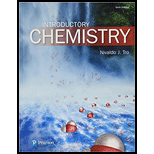
Concept explainers
Interpretation:
The formula for the compound that forms between a metal sodium and polyatomic anion, chlorite is to be written.
Concept introduction:
Ions that are composed of a group of atoms with an overall charge are known as polyatomic ions.
In order to write the formula for ionic compounds containing polyatomic ions, use the formula and charge of the polyatomic ions.
To write, the formula for the ionic compound that contains polyatomic ions, follow the following rules:
Write the symbol of the metal ion followed by the polyatomic ion’s symbol, their charges can be deduce from their group numbers in the periodic table.
The magnitude of the charge on each ion as a subscript is to be used as the subscript for the other ion.
Check, if the subscripts can be reduce to simpler whole numbers.
Check and confirm that the sum of the charge on the cation is equal to the sum of the charges of the polyatomic ions.
Want to see the full answer?
Check out a sample textbook solution
Chapter 5 Solutions
INTRODUCTORY CHEMISTRY-W/SEL.SOLN.MAN.
- What does it mean to say an equation is balanced? Why is it important for an equation to be balanced?arrow_forwardWhen an electric current is passed through an aqueous solution of NaCI, the valuable industrial chemicals H2(g), Cl2(g), and NaOH are produced. 2 NaCI(aq) + 2 H2O(l) H2(g) + Cl2(g) + 2 NaOH(aq) What mass of NaOH can be formed from 15.0 L of 0.35 M NaCI? What mass of chlorine is obtained?arrow_forwardA herbicide contains 2,4-D (2,4-dichlorophenoxyacetic acid), C8H6Cl2O3. A 1.236-g sample of the herbicide was decomposed to liberate the chlorine as Cl ion. This was precipitated as AgCl, with a mass of 0.1840 g. What is the mass percent of 2,4-D in the sample? 2,4-D (2,4-dichlorophenoxyacetic acid)arrow_forward
- Many cereals are made with high moisture content so that the cereal can be formed into various shapes before it is dried. A cereal product containing 58% H2O by mass is produced at the rate of 1000. kg/h. What mass of water must be evaporated per hour if the final product contains only 20.% water?arrow_forwardcertain transition metal ion (Mn+) forms a compound with oxygen (MxOy) . The molar mass of the compound is 250.2 g/mol. If the charge on the transition metal ion is +3, what is the identity of the transition metal, M? l type='a'> Th Ti Hg Ru Agarrow_forwardMany cereals are made with high moisture content so that the cereal can be formed into various shapes before it is dried. A cereal product containing 58% H2O by mass is produced at the rate of 1000. kg/h. What mass of water must be evaporated per hour if the final product contains only 20.% water?arrow_forward
- 3.87 Nitric acid (HNO3) can be produced by the reaction of ni- trogen dioxide (NO2) and water. Nitric oxide (NO) is also formed as a product. Write a balanced chemical equation for this reaction.arrow_forwardThe space shuttle environmental control system handles excess CO2 (which the astronauts breathe out; it is 4.0% by mass of exhaled air) by reacting it with lithium hydroxide, LiOH, pellets to form lithium carbonate, Li2CO3, and water. If there are seven astronauts on board the shuttle, and each exhales 20. L of air pee minute, how long could clean air be generated if there were 25,000 g of LiOH pellets available for each shuttle mission? Assume the density of air is 0.0010 g/mL.arrow_forward
 Introductory Chemistry: A FoundationChemistryISBN:9781337399425Author:Steven S. Zumdahl, Donald J. DeCostePublisher:Cengage Learning
Introductory Chemistry: A FoundationChemistryISBN:9781337399425Author:Steven S. Zumdahl, Donald J. DeCostePublisher:Cengage Learning Chemistry & Chemical ReactivityChemistryISBN:9781337399074Author:John C. Kotz, Paul M. Treichel, John Townsend, David TreichelPublisher:Cengage Learning
Chemistry & Chemical ReactivityChemistryISBN:9781337399074Author:John C. Kotz, Paul M. Treichel, John Townsend, David TreichelPublisher:Cengage Learning Chemistry & Chemical ReactivityChemistryISBN:9781133949640Author:John C. Kotz, Paul M. Treichel, John Townsend, David TreichelPublisher:Cengage Learning
Chemistry & Chemical ReactivityChemistryISBN:9781133949640Author:John C. Kotz, Paul M. Treichel, John Townsend, David TreichelPublisher:Cengage Learning Chemistry: An Atoms First ApproachChemistryISBN:9781305079243Author:Steven S. Zumdahl, Susan A. ZumdahlPublisher:Cengage Learning
Chemistry: An Atoms First ApproachChemistryISBN:9781305079243Author:Steven S. Zumdahl, Susan A. ZumdahlPublisher:Cengage Learning Chemistry for Engineering StudentsChemistryISBN:9781337398909Author:Lawrence S. Brown, Tom HolmePublisher:Cengage Learning
Chemistry for Engineering StudentsChemistryISBN:9781337398909Author:Lawrence S. Brown, Tom HolmePublisher:Cengage Learning Chemistry by OpenStax (2015-05-04)ChemistryISBN:9781938168390Author:Klaus Theopold, Richard H Langley, Paul Flowers, William R. Robinson, Mark BlaserPublisher:OpenStax
Chemistry by OpenStax (2015-05-04)ChemistryISBN:9781938168390Author:Klaus Theopold, Richard H Langley, Paul Flowers, William R. Robinson, Mark BlaserPublisher:OpenStax





